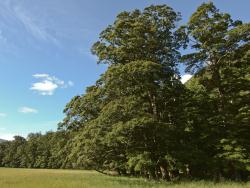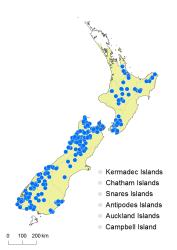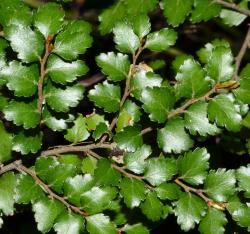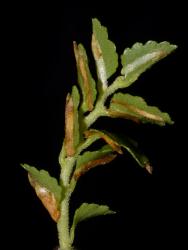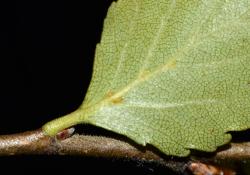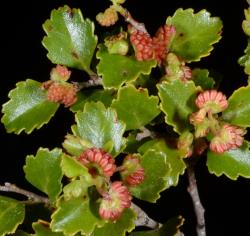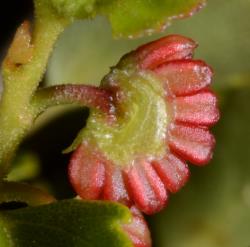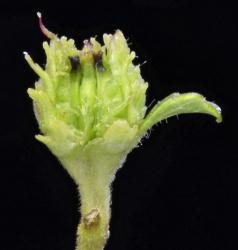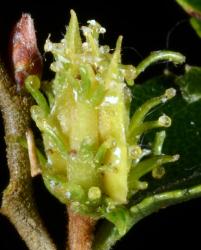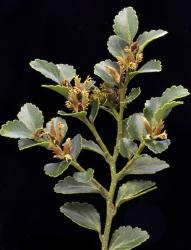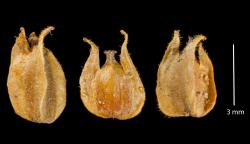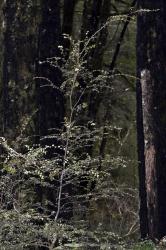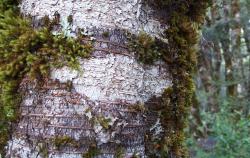- Taxon
- Gallery
- ≡ Fagus menziesii Hook.f. in Hooker, Icon. Pl. 7, t. 652 (1844)
- ≡ Nothofagus menziesii (Hook.f.) Oerst., Kongel. Danske Vidensk. Selsk. Skr., Naturvidensk. Math. Afd. 9: 355 (1871)
Prostrate to erect shrub to large tree, (0.5–)20–25(–30) m high; trunk straight cylindrical or short-boled and branching, 0.6–1.5(–2.6) m diameter, occasionally heavily buttressed; crown spreading. Young branchlets terete, grooved, red-brown, with fulvous pubescence. Stipules 3–4(–6) mm long, oblong to linear-oblong to narrow oblanceolate. Leaf lamina (4.8–)9–12(–30) × 5.5–14(–25) mm, broadly ovate or ovate-deltoid to orbicular, coriaceous, veins indistinct, 0–4 fringed domatia in basal axils, adaxially glossy green, glabrescent on veins toward base; abaxially lighter green, hispid on veins toward base; margins 1–2(–3) crenate, shortly ciliate in sinuses; apex obtuse to subacute; base cuneate to acute-truncate; petiole 1–4 mm long, pubescent. Staminate flowers 3–5/branchlet, on peduncles 2.5–4.5 mm long; perianth broadly campanulate, 1.5–2.5 mm long, glabrous, green, with 4–6 acute to obtuse lobes or lobes vestigial, margin ciliate. Stamens 22–36; filaments 1–2.5 mm long, glabrous; anthers 1–1.7 mm long, glabrous, pink, red or yellow. Pistillate inflorescences 1–5/branchlet, shortly pedunculate; dichasium ovoid with 2 or 3 sessile flowers/cupule, trimerous and dimerous or trimerous only, the dimerous flower often missing or atrophied, pubescent. Mature cupule 3.8–8 mm long, valves 4, narrow-triangular, coriaceous, resinous, hairy, apex subacute to acute; cupule appendages (3–)4–5 rows/valve, stalked, glandular. Nut (3–)4–5(–6) × (2–)3–4(–5) mm long, triquetrous or lenticular, pubescent, pale brown to red-brown, projected wing tips with glandular apices.
Bark and wood: Bark on young trees smooth, silver-grey with prominent horizontal white to brown lenticels; bark on old trees thick and furrowed with large flakes, light-grey to pinkish-brown or dark slaty-grey. Sapwood yellow to pink when fresh; heartwood light pink to red when fresh.
Juvenile leaves: Leaves similar to adult, smaller or larger depending on provenance, sometimes entirely red in colour.
Distinguished from all other southern beech by broadly ovate or ovate-deltoid to orbicular leaves which are doubly crenate on the margin. The bark on young trees is a distinctive silver-grey colour with prominent horizontal lenticels that are white to brown. Deeply pitted, fringed domatia commonly occur on the underside of the leaf.
North Island: South Auckland (Kaimai Range south of Te Aroha, Mamaku Plateau, Raukūmara Range, Urewera National Park, Hauhungaroa Range, Kaimanawa Range, Kaweka Range, Volcanic Plateau), Taranaki (isolated populations at Tangarakau River, lower Retaruke River). Wellington (northern Ruahine Range, Tararua, Rimutaka and Aorangi Ranges).
South Island: Nelson, Marlborough, Westland, Canterbury, Otago, Southland, Fiordland.
Altitudinal range, sea-level–1220 m a.s.l. (at Mt Honokawa, Raukūmara Range). Lowland to montane to sub-alpine forest and shrubland. Found in mixed broadleaf-conifer forests and in extensive pure stands. The dominant canopy tree with increasing altitude and moisture, and forming the treeline as a small tree or shrub. Also common in montane forests on mid-slope colluvium and river terraces in association with Fuscospora fusca and dominant at these sites or in mixed stands with podocarps outside the geographical range of F. fusca. Often occurs in association with F. cliffortioides in subalpine habitats but is less competitive with lower moisture and disturbance.
Flowering: Nov.–Jan. (mast seeding)



